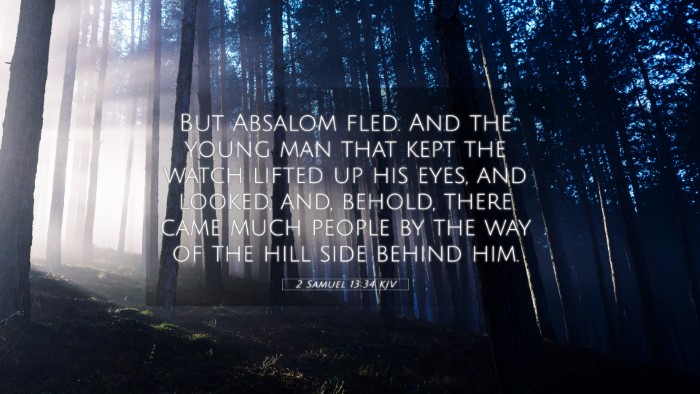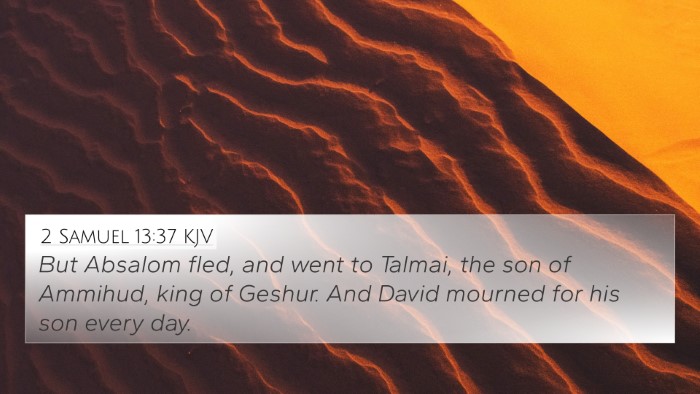Understanding 2 Samuel 13:34
The verse 2 Samuel 13:34 captures a scene of emotional turmoil and the grievous consequences of sin within the royal family of Israel. This verse is pivotal in the narrative surrounding the tragic events of Absalom's vengeance on Amnon. To help you grasp the meaning of this scripture, we will explore various public domain commentaries and connect this verse to other relevant Bible passages.
Verse Context
2 Samuel 13:34 reads: "But Absalom fled. And the young man that kept the watch lifted up his eyes and looked, and behold, there came much people by the way of the hill side behind him." This moment comes after Absalom has avenged his sister Tamar by killing Amnon, the only brother of Tamar and one of David's sons.
Commentary Insights
Matthew Henry's Commentary
Henry emphasizes the chaotic aftermath of Amnon's death, highlighting Absalom's flight as a symbol of shame and the tragedy of familial discord. His commentary notes that Absalom’s actions stemmed from a deep-seated desire for justice for Tamar, which drove him to commit fratricide. Henry also marks the ominous shift in Absalom’s character—a once charming son of David now becomes a fugitive consumed by guilt and fear.
Albert Barnes' Commentary
Barnes emphasizes the importance of the watchman’s role in the narrative, indicating that their vigilance is symbolic of spiritual watchfulness. The watchman perceiving Absalom's arrival signifies the unfolding of a significant change in the kingdom. Barnes often reflects on the sovereignty of God at work amid human actions, showcasing that despite Absalom's sin, God remains in control over the affairs of men.
Adam Clarke's Commentary
Clarke discusses the psychological components of Absalom's flight. He lays out that Absalom’s actions were not merely reactionary but deeply motivated by the desire for vindication. He draws connections to the implications of sin and the resulting consequences of estrangement from family and authority. Clarke further elaborates on the atmosphere of fear and dread, as Absalom realizes the magnitude of his deeds and the likelihood of being pursued for them.
Thematic Connections
This verse can be linked to the broader themes of family conflict, revenge, and the consequences of sin. Such themes resonate throughout the Bible, inviting further exploration of how they manifest in various scriptural accounts.
- Genesis 4:8 - Cain and Abel: another sibling conflict driven by jealousy and anger.
- Romans 12:19 - Christian principles regarding vengeance and leaving it to God.
- Proverbs 14:12 - A way that seems right to a man can end in destruction, highlighting the folly in Absalom’s pursuit of revenge.
- Galatians 6:7 - The principle of reaping what one sows parallels Absalom’s tragic trajectory.
- Matthew 5:7 - The Beatitudes reflect pure intentions and the consequences of mercy versus retribution.
- 2 Samuel 18:9-15 - Absalom's eventual fate serves as a stark warning about the cost of rebellion.
- James 1:20 - Human anger does not produce the righteousness of God, correlating with the sin that led Absalom to his grave.
Cross-Referencing Biblical Texts
The connections between 2 Samuel 13:34 and other biblical passages provide a deeper understanding of the narrative and its implications:
- 1 Kings 2:5 - The death of Joab highlights the pursuit of vengeance in David’s court.
- 2 Samuel 15:14 - The choices made by David's sons add layers of betrayal leading to Absalom's rebellion.
- Proverbs 3:5-6 - Trusting in the Lord versus lean on one’s understanding reflects the paths taken by Absalom and Amnon.
- Psalm 51 - David’s plea for mercy after his own sin shows the importance of recognizing wrongdoing and seeking restoration.
Conclusion
2 Samuel 13:34 serves not only as an account of Absalom’s flight but also as a warning about the far-reaching effects of sin within families and kingdoms. The insights gleaned from various commentators help illuminate the text, while connections to other scripture enhance our understanding of its themes. This verse acts as a critical junction, shedding light on the complexity of human emotion, the dire consequences of revenge, and the continual threads of familial strife throughout the Bible.
Utilizing tools for Bible cross-referencing enriches our study, revealing the intricate tapestry of connections woven throughout scripture that invites further reflection on themes of sin, redemption, and the pursuit of justice.






